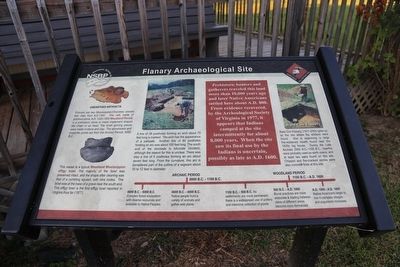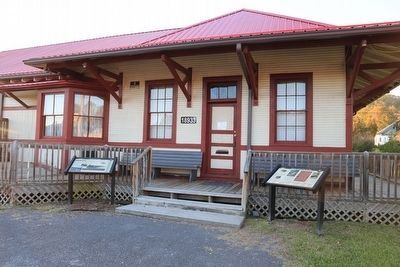Dungannon in Scott County, Virginia — The American South (Mid-Atlantic)
Flanary Archaeological Site
Archaic Period, 8000 B.C. – 1100 B.C.
8000 B.C. – 6000 B.C. — Complex forest ecosystem with diverse resources available to Native Peoples
6000 B.C. – 4000 B.C. — Native people hunt a variety of animals and gather wild plants
Woodland Period, 1100 B.C. – A.D. 1600
1100 B.C. – 500 B.C. — As settlements are more permanent, there is a widespread use of pottery and intensive collection of plants
500 B.C. – A.D. 1000 — Burial practices are more elaborate & trading between clans of different areas become more formalized.
A.D. 1000 – A.D. 1600 — Native Americans begin to live in complex villages and population increases.
Erected by Virginia Coal Heritage Trail and National Scenic Byways Program.
Topics. This historical marker is listed in these topic lists: Man-Made Features • Native Americans.
Location. 36° 49.657′ N, 82° 28.12′ W. Marker is in Dungannon, Virginia, in Scott County. Marker is on Veterans Memorial Highway (Virginia Route 65) west of Virginia Route 72, on the left when traveling east. Touch for map. Marker is in this post office area: Dungannon VA 24245, United States of America. Touch for directions.
Other nearby markers. At least 8 other markers are within 10 miles of this marker, measured as the crow flies. Dungannon Depot (here, next to this marker); Patrick Hagan and Dungannon (here, next to this marker); Patrick Porter (within shouting distance of this marker); Kilgore Fort House (approx. 6.6 miles away); Early Settlers in Russell County (approx. 7.7 miles away); Moore’s Fort (approx. 7.9 miles away); Coeburn (approx. 8 miles away); Houston’s Fort (approx. 9˝ miles away). Touch for a list and map of all markers in Dungannon.
More about this marker. Four photographs are shown on this interpretative panel, captioned as follows.
Unearthed Artifacts. Pictured are two Mississippian/Cherokee vessels that date from A.D. 1300. The celt, made of polished stone, A.D. 1200–1500 Woodland Period, is a prehistoric stone or metal implement shaped like a chisel or ax head. The small gaming pieces were made of stone and clay. The arrowheads
and projectile points are from the Archaic Period, 4000 B.C.
This vessel is a typical Woodland Mississippian effigy bowl. The majority of the bowl was preserved intact, and the shape after cleaning was that of a cymbling squash, with nine nodes. The bowl was at the base of a grave near the south end. This effigy bowl is the first effigy bowl reported in Virginia thus far (1977).
A line of 28 postholes forming an arch about 70 feet long is marked. The arch has the appearance of a palisade. Another line of 800 postholes forming an arc was about 100 feet long. The south end of the stockade is bifurcate (divided), although the reason for this is unclear. There was also a line of 5 posthols forming an ard about seven feet long. From the curvature, this arc is considered part of the outline of a wigwam about 10 to 15 feet in diameter.
Kate Cox Flanary, (1911–2004) grew up on the site where the artifacts were found. She is examining a large fire-reddened hearth found near the 1830s log house. During the Late Archaic 2500 B.C.–1100 B.C., hearths were probably used as earth ovens, and at least two were found on this site. Chipped and fire-cracked stones were also common finds at this site.
Credits. This page was last revised on June 16, 2016. It was originally submitted on November 25, 2015, by J. J. Prats of Powell, Ohio. This page has been viewed 780 times since then and 59 times this year. Photos: 1, 2. submitted on November 25, 2015, by J. J. Prats of Powell, Ohio.

